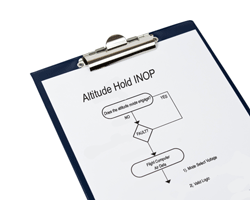Contributed by Avionics Tech Reps Curt Campbell and Larry Troyer

Asking the right questions at the right time, will lead you in the right direction towards a solution when troubleshooting an autopilot squawk.
Figuring out the cause of an autopilot (A/P) squawk is more involved than just looking up the symptoms and determining a course of action. It involves a rather complicated decision tree that includes several steps and scenarios. Altitude Hold INOP is a common A/P squawk that we encounter nearly every day. Below are some of the basic questions we ask that lead us in the right direction towards a correct solution.
Does the Altitude Mode show engaged?
If the altitude mode does not show engaged, the next step is to determine if the fault lies with the flight computer or air data. There are two main things required by the Flight Director (FD) computer in order for the Altitude Hold Mode to engage: 1) Mode Select voltage, and 2) Valid logic from the Air Data Sensor. If both signals are being transmited correctly to the FD computer, you can assume the FD computer is faulty.
Does the A/P drift off altitude?
If the A/P is drifting off altitude, first determine of the flight command bars are responding appropriately. For instance, if the A/P drifts off the altitude and the flight command bars do not recognize it and give the command to correct, the altitude error from the Air Data Sensor is not getting to the flight computer. This could be a faulty Air Data Sensor or FD computer. If the error can be confirmed as having reached the FD computer, then the computer is faulty.
However, if the flight command bars respond with corrective action when the A/P drifts off but the A/P doesn’t respond, I would took into the A/P amp or its connection to the FD computer. Another thing would be to check the Auto Trim. If the Auto Trim does not come in and take the effort away from the elevator servo after initial correction, the servo may run out of authority to hold the correction and allow the aircraft to drift off.
Does the A/P “hunt” for the altitude?
If the A/P hunts for the altitude, this could indicate either an altitude hold or pitch channel problem. Even though it may appear to be only an altitude hold failure, we need to remember in altitude hold, the A/P is trying to hold a tight reference of altitude against pitch attitude input. A pitch failure could be caused by any number of other parameters that will appear more often during altitude hold, due to the tight reference.
As you can see, there is no obvious answer to an Autopilot Altitude Hold INOP squawk and these questions are not all-inclusive. We haven’t addressed cable tensions or servo motors. When troubleshooting Auto Pilot squawks, don’t be discouraged if the answer isn’t obvious.
Lear more about Basic Autopilot Troubleshooting from Curt and Larry as they present at the 55th Annual AEA International Convention and Trade Show in Washington, D.C., from April 3-6, 2012.
Curt Campbell and Larry Troyer are Duncan Aviation Avionics Tech Reps. located in Lincoln, NE, specializing in troubleshooting squawks and offering tech support for business aircraft avionics. Curt's aviation career began in 1975. Larry's aviation career began in 1982.


